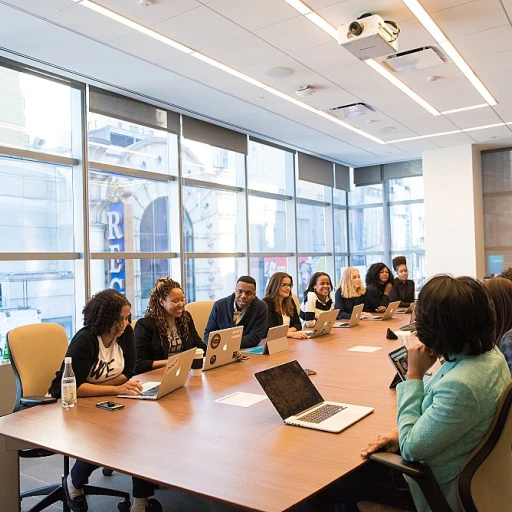Understanding the Dynamics of Rapid Growth
The Growth Challenge: Keeping Up with Expansion
When a company starts growing quickly, it's like a rollercoaster ride—exciting but also a bit nerve-wracking. For employees, this can mean more opportunities but also more stress. It's crucial to understand that rapid growth can put a strain on both the company and its people. The employee journey becomes more complex, and the company culture can shift, sometimes leaving employees feeling lost.
Maintaining Work-Life Balance Amidst Growth
With growth comes increased workload, and this can affect work-life balance. Employees might find themselves juggling more tasks, which can lead to burnout if not managed well. Companies need to be proactive in supporting their teams by promoting a healthy work-life balance. This might include flexible work hours or remote work options, allowing employees to manage their personal and professional lives more effectively.
Continuous Learning as a Growth Strategy
Rapid expansion often demands new skills and knowledge. Employees should have access to continuous learning opportunities to keep up with the evolving demands of their roles. This not only boosts employee satisfaction but also prepares them for future challenges. Investing in learning and development shows employees that the company values their growth, which can improve employee engagement and retention.
Building a Resilient Company Culture
As companies grow, maintaining a positive employee culture becomes even more important. A strong, supportive culture can help employees feel connected and engaged, even during periods of change. It's essential for organizations to communicate their values clearly and involve employees in decision-making processes to foster a sense of belonging.
In summary, understanding the dynamics of rapid growth is key to improving employee experience. By focusing on work-life balance, continuous learning, and a resilient culture, companies can navigate the challenges of expansion while keeping their employees happy and engaged.
Creating a Supportive Work Environment
Building a Strong Foundation for Employee Well-being
Rapid growth can sometimes feel like a whirlwind, leaving employees gasping for air. So how does a company in high-speed mode keep its employees satisfied and humming along? Start with crafting a solid work environment that offers emotional and psychological safety. This isn't just about cushy chairs and free coffee. It dives deep into cultivating a place where people feel empowered and valued. Encourage open and honest communication. By actively listening, employers demonstrate that employees' thoughts matter. This establishes trust—an essential element for any thriving organization. Someone once said, "People don’t leave jobs, they leave managers," which rings true, particularly during periods of intense growth.Fostering a Culture of Continuous Learning
A company's growth opens doors for employees to stretch professionally. Create those opportunities! Investing in skill development and career growth isn't just an add-on; it's a must-have for ramping up employee satisfaction and engagement. Leaders need to focus on providing the tools and resources for continuous learning. Support for work-life balance, remote work options, and mental health programs should be as accessible as water in the office cooler. Yes, offering online courses and workshops is a fantastic boost to the skill set, but reminding employees to take regular breaks and consider life balance is equally vital. Infuse some learning into daily work. Project management roles or customer experience tasks can serve as on-the-job mastery sessions. Equipping everyone with new skills means everyone shares in the growth pie.Empowering Employee Journey with Effective Communication
As companies grow, networks get bigger, and so do the chances of miscommunication. Keeping messages clear and frequent lets employees stay updated, reducing uncertainty. Make communication two-way, offering employees channels to share feedback. Leaders who practice open-door policies and regular team check-ins ensure no one feels left out in the company's rapid ascent. This approach roots a sense of belonging and teamwork, which naturally pumps up engagement levels. By providing clear, regular updates, businesses can create an informed and cohesive team ready to tackle challenges head-on, ever prepared for future growth spurts. Establishing straightforward communication cuts errors and boosts team spirit like nothing else. For more on the intricacies of employee engagement strategies, you may find further insights on how HR shapes employee experience for success. Keeping employees satisfied in a fast-growing company isn't magic — it’s about intentional, thoughtful strategies that prioritize employee experience over simple numbers.Effective Communication in Expanding Teams
Open Channels Foster Trust
Effective communication is the lifeblood of any thriving organization, especially those in a period of fast growth. Rapid transitions can leave employees feeling like they’re on shifting sands. Consistency in updates, clear directives, and available platforms for feedback go a long way in establishing trust. People are more inclined to give their best when they feel informed and valued by their employer.Encouraging Two-Way Conversations
Let’s face it – nobody enjoys a one-sided conversation, especially in a work environment. Encouraging open dialogue allows ideas to flow, sparking innovation while also addressing any employee concerns early on. This mutual exchange fosters a supportive work atmosphere, enhancing both employee satisfaction and the company’s success.Adapting to New Communication Tools
Today's workplace communication has undergone significant changes with the advent of digital tools. Whether it’s through instant messaging platforms, video calls, or collaborative project management systems, these advances offer a way to maintain engagement and overcome the hurdles of remote work. By embracing new technology, companies can improve employee engagement and bring their teams closer, no matter how physically apart they might be.Nurturing a Positive Company Culture
It’s about creating a culture where people feel they belong. Communication isn’t just about conveying information – it’s about reflecting the company values, highlighting successes, and celebrating milestones together. Cultivating a sense of community keeps employees motivated and invested in the organization’s goals. When you let the culture shine as the backbone of communication, everybody feels like a vital piece in the larger company puzzle.Feedback Mechanisms for Continual Improvement
Every growing company benefits from actively listening to its team members. Establishing effective feedback channels allows businesses to adjust and hone their strategies. Incorporating employee input can lead to continuous learning and improvement within the organization, reinforcing the positive employee experience and driving success across the board. To dive deeper into tailoring a meaningful employee journey for optimal engagement, explore this valuable resource.Talent Retention Strategies
Staying Ahead with Talent Retention
In rapidly expanding companies, the race to hire and retain top talent is a never-ending challenge. Rapid growth often means increased workloads, heightened stress, and the ever-looming risk of valuable employees jumping ship for better prospects elsewhere. But have no fear, there are effective ways to keep talent engaged and committed. One of the cornerstones of a positive employee experience is providing a well-balanced work life. Offering flexible working hours, especially in today's remote work era, allows employees to manage their work life better and increase job satisfaction. By delivering a solid work environment and promoting mental health awareness, companies can help employees feel more connected and valued. Another line of attack is enhancing career development opportunities that cater to each employee's journey. Equip your team with tools for continuous learning, and don't shy away from empowering them with project management responsibilities. Learning and personal growth is a biggie, as many employees seek to improve themselves and climb the professional ladder. Promoting an engaging company culture that reflects the values and goals of the employees is also part of the equation. Recognizing achievements and appreciating efforts boosts employee morale and satisfaction, paving the way for strengthened employee engagement. Lastly, use data-driven insights to identify what makes employees tick. Regular feedback sessions can provide essential information on what needs improvement. By understanding and acting on these insights, employers can enhance employee satisfaction and keep top talent within the organization, fostering long-term business success. Don't underestimate the value of a supportive organization. It goes beyond customer experience, impacting everything from employee engagement to improving employee happiness. With smart strategies and the right balance, your company will create a magnet for retaining talent, all while driving growth forward. Remember, employees aren't just workers; they're your company's most valuable asset. Treat them well, and they'll improve employee dynamics within the organization, ultimately helping to anchor your business's future success.Leveraging Technology for Better Employee Experience
Tech Tools that Empower Employees
In rapidly growing companies, technology plays a vital role in shaping a positive employee experience. With the right tools, businesses can create an environment where employees feel supported and engaged. From project management software to communication platforms, technology helps streamline processes and foster a sense of community among team members.
Boosting Engagement with Learning Platforms
Continuous learning is a cornerstone of employee satisfaction. Companies that offer access to online courses and training platforms not only enhance their employees' skills but also show a commitment to their career development. This investment in learning can lead to increased job satisfaction and a more motivated workforce.
Balancing Work and Life with Remote Work Solutions
Remote work tools have become essential in providing flexibility and improving work-life balance. By equipping employees with reliable video conferencing and collaboration tools, organizations can maintain productivity while allowing people to work from anywhere. This flexibility is crucial in retaining top talent and ensuring mental health and well-being.
Using Data to Improve Employee Experience
Data-driven insights are invaluable for understanding employee needs and improving their experience. By collecting and analyzing data on employee engagement and satisfaction, companies can make informed decisions to enhance their work culture. This approach not only boosts morale but also aligns with business goals, creating a win-win situation for everyone involved.
Measuring and Improving Employee Satisfaction
Keeping a Pulse on Employee Sentiment
Understanding how employees feel about their work life and environment is vital. Regular surveys and feedback sessions can offer valuable insights into employee satisfaction. These tools help in identifying areas where employees might be struggling or thriving, allowing companies to make informed decisions that improve employee experience. It's not just about gathering data, but about acting on it to create a positive work culture.
Using Technology to Your Advantage
With the growth of remote work and digital tools, companies have more opportunities than ever to enhance employee engagement. Tools like project management software and communication platforms can streamline processes and keep teams connected. However, it's crucial to ensure these tools are user-friendly and genuinely improve the employee journey, rather than adding unnecessary complexity.
Fostering Continuous Learning and Development
Investing in career development opportunities is a win-win for both employees and the organization. By offering training programs and learning resources, companies can help employees grow their skills, which in turn boosts job satisfaction and retention. This focus on continuous learning supports a culture where employees feel valued and motivated to contribute to the company's growth.
Balancing Work and Life
Achieving a healthy work-life balance is essential for maintaining mental health and job satisfaction. Companies should encourage flexible work arrangements and respect personal time to ensure employees don't feel overburdened. This approach not only improves employee satisfaction but also enhances productivity and loyalty.
Building a Culture of Recognition
Recognizing and rewarding employees for their hard work can significantly impact their engagement and satisfaction. Simple gestures of appreciation can go a long way in making employees feel valued and motivated. Acknowledging achievements and contributions helps foster a positive employee experience and strengthens team morale.








